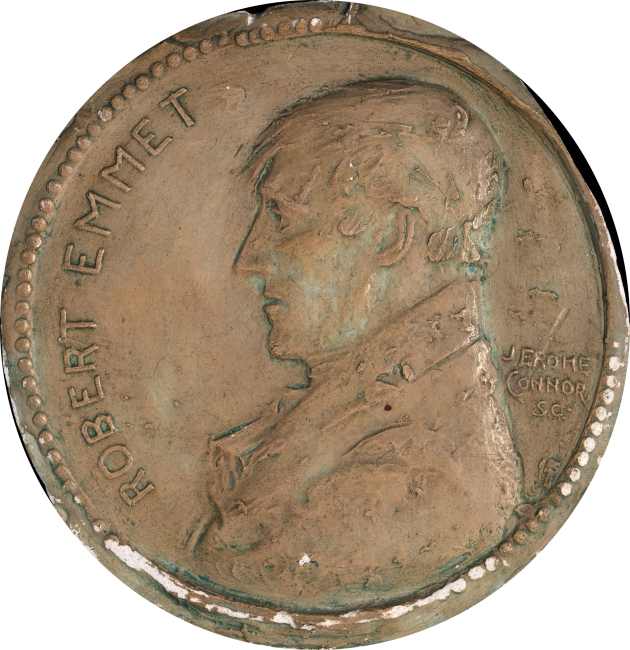
Jerome Connor and Robert Emmet
The CSIA collection is home to a selection of handwritten letters by Jerome Connor to various recipients including William T. Emmet, Thomas P. Tuite, and Dr. Thomas Addis Emmet. An emerging theme in these letters is Connor’s sculptural works of the Irish Republican and nationalist patriot, Robert Emmet.
Jerome Connor was an Irish sculptor and artist. Originally from County Kerry, Connor and his family moved to Holyoke in Massachusetts in 1888. There he trained as a stone carver and in c.1896 he relocated to New York and joined the Roycroft community at East Aurora. Connor then moved to Washington and began to produce various memorials including a one to Robert Emmet for the Smithsonian Museum.
Connor and Washington D.C.
In this handwritten letter by Connor to William T. Emmet, he discusses the statue of Robert Emmet for the National Gallery of Art in Washington. Connor mentions that he has sent William photographs of his sculptural model stating that he ‘has worked entirely from the information provided by Dr. Thomas Addis Emmet’ (the grandson of Robert Emmet). Connor goes on to say that the statue represents Robert Emmet ‘at the moment he is about to give up his life for his country.'
Connor concludes the letter by asking for the opinions of both William and Dr. Thomas before he proceeds to the full-size model. This letter illuminates certain aspects of Connor’s artistic process, including his attempt to capture a profound moment in the life of Robert Emmet for this particular sculpture.
The second letter in this collection is by Connor to Thomas P. Tuite and pertains to the Smithsonian museum. Connor discusses how the Board of Regents of the museum offered him a space for a sample of his work and writes that he accepted the offer ‘providing they would let me place a statue of Robert Emmet there (I know that the opportunity would not come again to get an Emmet into a government institution)’. Connor’s enthusiasm to represent Emmet in a prominent American institution during such a tumultuous time in Irish politics reveals aspects of his personal beliefs including his presumed nationalism. The bronze sculpture of Robert Emmet was gifted to the Smithsonian American Art Museum in 1916, the same year as the Easter rising which lead to the War of Independence, the Irish Civil War, and the establishment of the Irish Free State in 1922.
Good Irishmen
Connor’s interpretation of Robert Emmet was often informed by Dr. Thomas Addis Emmet who appears to approve his work in one particular letter. Connor notes that he is now working on the full-size model of Robert Emmet and will send on photographs once he has completed it. He asks Dr. Emmet for ‘a print of the fob worn by R.E’ with the hope of including it in the statue. Connor’s relationship with Dr. Emmet was no doubt of great importance to him as it connected him directly to his source of inspiration.
In another letter on the 21st of February 1915, Connor writes to Tuite and states ‘our mission is to keep his name [Robert Emmet] before the Irish people, and if they believe in him they won’t go wrong. They’ll be good Irishmen, and that’s all we’ll ask of them.’ His devotion to Emmet is evident in this letter as we peer into his mindset during this time. He implies that the presence of a Robert Emmet statue will embed itself in the minds of Irish people and encourage nationalist sentiment. One could speculate Connor’s belief in art as a powerful political and cultural tool.
Final Steps
On the 26th of August, 1915, Connor apologises for not visiting Tuite as he ‘slipped home’ to attend to his ‘real business.’ He writes that he has finished a life-sized bust of Emmet, a small medallion, and a brand new sketch, all of which embody the information provided by Dr. Thomas Emmet. Connor goes on to say that he hopes to be back in New York with his works by Labour Day and with regards to the Emmet statue, he writes:
‘[the] technical part is in good shape and all we need is a little more of the “necessary evil” to put it through - and we will get that.’
This collection of letters allows the reader to investigate and speculate on the life and artistic career of this prominent Irish artist. His time spent in the United States is a source of great interest as he appealed to a large Irish American audience that sympathised with the nationalist movement taking place in Ireland during that time.
Credit
Grace O'Boyle, ESB CSIA Fellow
Published online: 2021